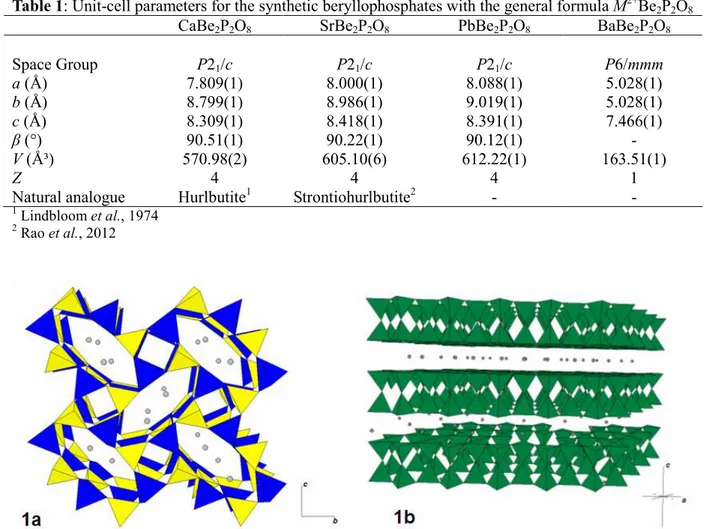Crystal chemisty of M2+Be2P2O8 (M2+ = Ca, Sr, Pb, Ba) beryllophosphates: a comparison with feldspar analogues
F. Dal Bo1*, F. Hatert1, C. Rao2
1 Laboratory of Mineralogy B.18, University of Liège, B-4000 Liège, Belgium. (*fdalbo@ulg.ac.be) 2 Department of Earth Sciences, Zhejiang University, Hangzhou 310027, China.
Only 27 natural beryllophosphates are reported in the litterature, occuring mainly in granitic pegmatites and resulting from the reaction of beryl with P-bearing hydrothermal solutions (Kampf, 1992; Cerný, 2002). The formation of these minerals is highly dependent upon the pH, the temperature, the availability of specific alkali cations, and the Be/P ratio of the solution (Kampf et al., 1992). Despite their low abundance, beryllophosphates crystallize in many structure types, characterized by different polymerization degrees of the BeO4-PO4 tetrahedra: these compounds form chain structures (fransoletite [Ca3Be2(PO4)2(PO3OH)2.4H2O], väyrynenite [MnBe(PO4)(OH)]), sheet structures (herderite [CaBe(PO4)(F,OH)], uralolite [Ca2Be4(PO4)3(OH)3.5H2O]), framework structures (hurlbutite [CaBe2P2O8], babefphite [BaBe(PO4)F], beryllonite [NaBe(PO4)]), and structures containing clusters of tetrahedra (gainesite [Na2Zr2[Be(PO4)4].1.5H2O]) (Hawthorne & Huminicki, 2002). Furthermore, Harvey & Meier (1989) have synthesized five beryllophosphates with zeolite-type structures. Recently the new mineral strontiohurlbutite [SrBe2P2O8] was discovered in the Nanping No. 31 pegmatite, Fujian Province, China (Rao et al., 2012).
The low number of natural and synthetic beryllophosphates reported in the literature prompted us to investigate the M2+-Be-PO4 system (M
2+
= Ca, Sr, Pb, Ba, Zn, Cd), by using hydrothermal synthesis techniques at low temperature (200°C) and low pressure (autogenous pressure), and high temperature (400°C and 600°C) and high pressure (1 kbar). The experiments at low temperature and pressure were performed in Parr autoclaves, using BeO, H3PO4, CaHPO4, Sr(NO3)2, Pb(NO3)2, Ba(OH)2.8H2O, Zn(OH)2 or Cd(OH)2 as starting materials. In the case of experiments at high temperature and pressure, crystals synthesized at low temperure-pressure were crushed and used as starting material.
During these synthesis different beryllophosphates were obtained: CaBe2P2O8, SrBe2P2O8, PbBe2P2O8 and BaBe2P2O8. These compounds have large stability fields and are observed in all the hydrothermal synthesis performed whatever the temperature and pressure conditions applied. The crystallographic parameters of these compounds are listed in the Table 1. CaBe2P2O8, SrBe2P2O8 and PbBe2P2O8 crystallized in the same space group and are isostructural. Their structure consists of corner-sharing BeO4 and PO4 tetrahedra assembled in 4- and 8-membered rings; these rings are perpendicular to the a axis. The 4-membered rings consist of a pair of tetrahedra pointing upwards (U) and a pair of tetrahedra pointing downwards (D), and therefore UUDD type rings are observed. The 8-membered rings are formed by linking four 4-membered rings, and show only one pattern: DDUDUUDU (Fig. 1a). BeO4 and PO4 tetrahedra are also connected by corner-sharing to form a double crankshaft chain running along the a axis. The bivalent cations are located in the 8-membered rings and occur in 7+3-coordinated polyhedron, characterized by 7 short bonds and 3 long bonds. By considering only the 7 shortest bonds, this polyhedron can be described as a combination of a square pyramid and of a trigonal prism, with one square face in common.
Stuctural crystallography of beryllophosphates with formula M2+-Be-PO4 (M2+ = Ca, Sr, Pb) is fascinating, since their structures can be compared to those of aluminosilicates belonging to the feldspar family (anorthite [Ca(Al2Si2O8)], slawsonite [Sr(Al2Si2O8)], and paracelsian [Ba(Al2Si2O8)]), to those of borosilicates as danburite [CaB2Si2O8] and pekovite [SrB2Si2O8], and to those of the synthetic compounds SrGa2Si2O8 and SrGa2Ge2O8.
BaBe2P2O8 showed a structure completely different from the other beryllophosphates investigated in this study. The structure of BaBe2P2O8 is based on a double layer of tetrahedra containing both berylium and phosphorus in a 1/1 ratio. These tetrahedra are assembled in 6-membered rings forming channels parallel to the c axis. Parallel to the a-b plane, a ring is connected to 6 other rings to form an infinite layer. In the c direction, the tetrahedra are also linked by their apical oxygens, thus forming a double layer with all tetrahedra of the same layer pointing in one direction (Fig. 1b). These layers are connected by the Ba atoms, located in a twelve-coordinated polyhedra.
The Ba polyhedra has a very regular hexagonal shape and showed 12 identical bonds of 2.976(2) Å lenght. This barium beryllium phosphate is isostructural with dmisteinbergite, a hexagonal polymorph of CaAl2Si2O8 (Takéuchi & Donnay, 1959).
Table 1: Unit-cell parameters for the synthetic beryllophosphates with the general formula M2+Be2P2O8 CaBe2P2O8 SrBe2P2O8 PbBe2P2O8 BaBe2P2O8
Space Group P21/c P21/c P21/c P6/mmm a (Å) 7.809(1) 8.000(1) 8.088(1) 5.028(1) b (Å) 8.799(1) 8.986(1) 9.019(1) 5.028(1) c (Å) 8.309(1) 8.418(1) 8.391(1) 7.466(1) β (°) 90.51(1) 90.22(1) 90.12(1) - V (ų) 570.98(2) 605.10(6) 612.22(1) 163.51(1) Z 4 4 4 1
Natural analogue Hurlbutite1 Strontiohurlbutite2 - -
1
Lindbloom et al., 1974
2
Rao et al., 2012
Fig. 1a. Structure of CaBe2P2O8: SrBe2P2O8 and PbBe2P2O8; PO4 are yellow, BeO4 are blue and spheres represent M2+ cations. 1b. Structure of BaBe2P2O8: (Be,P)O4 are green and spheres represent Ba atoms. References:
Cerný, P. (2002): Mineralogy of Beryllium in Granitic Pegmatites. Reviews in Mineralogy & Geochemistry. 50, 405-444.
Harvey, G. & Meier, W.M. (1989): The Synthesis of Beryllophosphate Zeolites. Zeolites: Facts, Figures, Future. 49, 237-254.
Hawthorne, F.C. & Huminicki, D.M.C. (2002): The Crystal Chemistry of Beryllium. Reviews in Mineralogy & Geochemistry. 50, 333-403.
Kampf, A.R. (1992): Beryllophosphate chains in the structures of fransoletite, parafransoletite and erleite and some general comments on beryllophosphate linkages. American Mineralogist. 77, 848-856.
Kampf, A.R., Dunn, P.J., Foord, E.E. (1992): Parafransoletite, a new dimorph of fransoletite from the Tip Top Pegmatite, Custer, South Dakota. American Mineralogist. 77, 843-847.
Lindbloom, J. T., Gibbs, G. V. and Ribbe, P. H. (1974): The crystal structure of hurlbutite: a comparison with danburite and anorthite. American Mineralogist 59, 1267-1271.
Rao, C., Wang, R., Gu, X., Hu, H. and Dong, C. (2012): Strontiohurlbutite, IMA 2012-032. CNMNC Newsletter No. 14, October 2012, page 1285; Mineralogical Magazine, 76, 1281-1288.
Takéuchi, Y. & Donnay, G. (1959): The crystal structure of hexagonal CaAl2Si2O8, Acta Crystallographica 12, 465-470.
